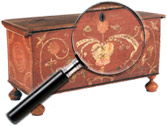Nicolai Ivanovich Fechin (Russian, American, 1881 to 1955)
Nicolai Fechin was born in 1881 in the city of Kazan near the Volga River to a craftsman who gave his son his earliest instruction in drawing and sculpting. At fourteen, he enrolled at the Art School of Kazan, then studied at the Imperial Academy in St. Petersburg, from which he eventually graduated in 1908. In just a few years, the young artist attained international success, winning a Prix de Rome scholarship and a gold medal at a Munich exhibition.
In 1910, Fechin’s work received its initial exposure in the United States when the artist submitted works to the first of several International Exhibitions at Pittsburgh’s Carnegie Institute. There, his works caught the attention of dealer William S. Stimmel who began selling his paintings in the United States. After taking a teaching position at the Art School of Kazan, Fechin married Alexandra, the favorite daughter of the school’s director, aristocrat Nicolai Belkovich, in 1913.
Together they led a comfortable existence until the violence and uncertainty brought on by the Russian Civil War made life increasingly perilous. In his autobiography, Fechin later described the impact that the war had on his art:
“…the ground beneath one’s feet was lost altogether, there being no certainty whatever of what tomorrow would bring. Nerves were completely worn out. I felt how swiftly and uselessly I was losing my creative energy. All art was used for propaganda. The usual tempo of work became impossible…All commissions had to be done with such poor materials that, of course, the paintings deteriorated rapidly. Work lost all logical sense and one tended to fall into unbearable spiritual melancholy” (Eya Fechin Branham collection, 1953-1954, p. 33).
By the early 1920s, Fechin made the decision to immigrate to the United States with Alexandra and their young daughter Eya. With the help of Stimmel and several prominent patrons, such as architect John Burnham, he arrived in New York City in August 1923 at the age of forty-two. Once in New York, Fechin became extremely productive, taking full advantage of newfound access to high quality painting materials and the strong market for his work.
Information courtesy of Sotheby’s, December, 2008.
